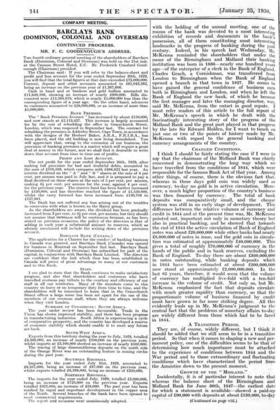CHANGED CONDITIONS.
I think I should be fairly stating the case if I were to say that the chairman of the Midland Bank was chiefly concerned in demonstrating the long way which we have travelled from the conditions of 1844, which were responsible for the famous Bank Act of that year. Among other things, of course, there is the obvious fact that, whereas in those days gold coin was widely used as currency, to-day no gold is in active circulation. More- over, a much higher proportion of the country's business was then financed by currency. The total of bank deposits was comparatively small, and the cheque system was still in an early stage of development. This difference between the relative volumes of currency and credit in 1844 and at the present time was, Mr. McKenna pointed out, important not only in monetary theory but also in practical banking, and he showed that .towartis the end of 1844 the active circulation of Bank of England notes was about £20,000,000 while other banks had nearly £8,000,000 of notes in issue, and the gold coin in circula- tion was estimated at approximately £40,000,000. This gives a total of roughly £70,000,000 of currency in the hands of the public and in bank reserves, excluding the Bank of England. To-day there are about £360,000,000 in notes outstanding, while banking deposits which in 1844 have been estimated at about £200,000,000 now stand at approximately £2,000,000,000. In the last 85 years, therefore, it would seem that the volume of currency has multiplied five-fold with a ten-fold increase in the volume of credit. Not only so, but Mr. McKenna emphasized the fact that deposits circulate with much greater rapidity than currency, so that the proportionate volume of business financed by credit must have grown in far more striking degree. All this evidently leads up in Mr. McKenna's judgment to the central fact that the problems of monetary affairs to-day are widely different from those which had to be faced in 1844.






































 Previous page
Previous page